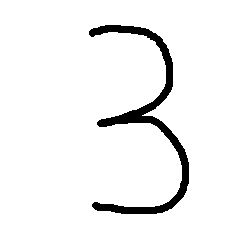Tensorflow学习教程------模型参数和网络结构保存且载入,输入一张手写数字图片判断是几
首先是模型参数和网络结构的保存
#coding:utf-8
import tensorflow as tf
from tensorflow.examples.tutorials.mnist import input_data mnist = input_data.read_data_sets('MNIST_data',one_hot=True)
#每个批次的大小
batch_size = 100
n_batch = mnist.train._num_examples // batch_size
#定义两个placeholder
x = tf.placeholder(tf.float32, [None,784],name='x-input' ) #模型输入的地方加名字
y = tf.placeholder(tf.float32,[None,10])
keep_prob = tf.placeholder(tf.float32,name='keepProb') def weight_variable(shape):
initial = tf.truncated_normal(shape,stddev=0.1) #生成一个截断的正态分布
return tf.Variable(initial)
def bias_variable(shape):
initial = tf.constant(0.1,shape = shape)
return tf.Variable(initial)
#卷基层
def conv2d(x,W):
return tf.nn.conv2d(x,W,strides=[1,1,1,1],padding='SAME')
#池化层
def max_pool_2x2(x):
return tf.nn.max_pool(x,ksize=[1,2,2,1],strides=[1,2,2,1],padding='SAME') #改变x的格式转为4D的向量[batch,in_height,in_width,in_channels]
x_image = tf.reshape(x, [-1,28,28,1]) #初始化第一个卷基层的权值和偏置
W_conv1 = weight_variable([5,5,1,32]) #5*5的采样窗口 32个卷积核从一个平面抽取特征 32个卷积核是自定义的
b_conv1 = bias_variable([32]) #每个卷积核一个偏置值 #把x_image和权值向量进行卷积,再加上偏置值,然后应用于relu激活函数
h_conv1 = tf.nn.relu(conv2d(x_image,W_conv1)+b_conv1)
h_pool1 = max_pool_2x2(h_conv1) #进行max-pooling #初始化第二个卷基层的权值和偏置
W_conv2 = weight_variable([5,5,32,64]) # 5*5的采样窗口 64个卷积核从32个平面抽取特征 由于前一层操作得到了32个特征图
b_conv2 = bias_variable([64]) #每一个卷积核一个偏置值 #把h_pool1和权值向量进行卷积 再加上偏置值 然后应用于relu激活函数
h_conv2 = tf.nn.relu(conv2d(h_pool1,W_conv2) + b_conv2)
h_pool2 = max_pool_2x2(h_conv2) #进行max-pooling #28x28的图片第一次卷积后还是28x28 第一次池化后变为14x14
#第二次卷积后 变为14x14 第二次池化后变为7x7
#通过上面操作后得到64张7x7的平面 #初始化第一个全连接层的权值
W_fc1 = weight_variable([7*7*64,1024])#上一层有7*7*64个神经元,全连接层有1024个神经元
b_fc1 = bias_variable([1024]) #1024个节点 #把第二个池化层的输出扁平化为一维
h_pool2_flat = tf.reshape(h_pool2,[-1,7*7*64])
#求第一个全连接层的输出
h_fc1 = tf.nn.relu(tf.matmul(h_pool2_flat,W_fc1)+b_fc1) #keep_prob用来表示神经元的输出概率 h_fc1_drop = tf.nn.dropout(h_fc1,keep_prob) #初始化第二个全连接层
W_fc2 = weight_variable([1024,10])
b_fc2 = bias_variable([10]) #计算输出
prediction = tf.nn.softmax(tf.matmul(h_fc1_drop,W_fc2)+b_fc2, name='output') #模型输出的地方加名字 #交叉熵代价函数
cross_entropy = tf.reduce_mean(tf.nn.softmax_cross_entropy_with_logits(labels=y,logits=prediction)) #使用AdamOptimizer进行优化
train_step = tf.train.AdamOptimizer(1e-4).minimize(cross_entropy)
#结果存放在一个布尔列表中
correct_prediction = tf.equal(tf.argmax(prediction,1),tf.argmax(y,1)) #argmax返回一维张量中最大的值所在的位置
#求准确率
accuracy = tf.reduce_mean(tf.cast(correct_prediction,tf.float32)) with tf.Session() as sess:
sess.run(tf.global_variables_initializer())
for epoch in range(10):
for batch in range(n_batch):
batch_xs,batch_ys = mnist.train.next_batch(batch_size)
sess.run(train_step,feed_dict={x:batch_xs,y:batch_ys,keep_prob:0.7})
acc = sess.run(accuracy,feed_dict={x:mnist.test.images,y:mnist.test.labels,keep_prob:1.0})
print ("Iter "+ str(epoch) + ", Testing Accuracy= " + str(acc))
#保存模型参数与网络结构
output_graph_def = tf.graph_util.convert_variables_to_constants(sess,sess.graph_def,output_node_names=['output'])
#保存模型到目录下的model文件夹中
with tf.gfile.FastGFile('/home/bayes/mymodel.pb',mode='wb') as f:
f.write(output_graph_def.SerializeToString())
结果
Iter 0, Testing Accuracy= 0.8616
Iter 1, Testing Accuracy= 0.9663
Iter 2, Testing Accuracy= 0.9776
Iter 3, Testing Accuracy= 0.9815
Iter 4, Testing Accuracy= 0.985
Iter 5, Testing Accuracy= 0.9863
Iter 6, Testing Accuracy= 0.9871
Iter 7, Testing Accuracy= 0.9895
Iter 8, Testing Accuracy= 0.9878
Iter 9, Testing Accuracy= 0.9894
Converted 8 variables to const ops.
载入模型参数与网络结构,并且预测图片
#coding:utf-8
import tensorflow as tf
from tensorflow.examples.tutorials.mnist import input_data
from PIL import Image,ImageFilter
mnist = input_data.read_data_sets('MNIST_data',one_hot=True)
#定义一个placeholder
y = tf.placeholder(tf.float32,[None,10]) def imageprepare(argv): # 该函数读一张图片,处理后返回一个数组,进到网络中预测
im = Image.open(argv).convert('L')
width = float(im.size[0])
height = float(im.size[1])
newImage = Image.new('L', (28, 28), (255)) # creates white canvas of 28x28 pixels if width > height: # check which dimension is bigger
# Width is bigger. Width becomes 20 pixels.
nheight = int(round((20.0 / width * height), 0)) # resize height according to ratio width
if nheight == 0: # rare case but minimum is 1 pixel
nheight = 1
# resize and sharpen
img = im.resize((20, nheight), Image.ANTIALIAS).filter(ImageFilter.SHARPEN)
wtop = int(round(((28 - nheight) / 2), 0)) # caculate horizontal pozition
newImage.paste(img, (4, wtop)) # paste resized image on white canvas
else:
# Height is bigger. Heigth becomes 20 pixels.
nwidth = int(round((20.0 / height * width), 0)) # resize width according to ratio height
if (nwidth == 0): # rare case but minimum is 1 pixel
nwidth = 1
# resize and sharpen
img = im.resize((nwidth, 20), Image.ANTIALIAS).filter(ImageFilter.SHARPEN)
wleft = int(round(((28 - nwidth) / 2), 0)) # caculate vertical pozition
newImage.paste(img, (wleft, 4)) # paste resized image on white canvas # newImage.save("sample.png") tv = list(newImage.getdata()) # get pixel values # normalize pixels to 0 and 1. 0 is pure white, 1 is pure black.
tva = [(255 - x) * 1.0 / 255.0 for x in tv]
return tva
#载入模型
with tf.gfile.FastGFile('/home/bayes/mymodel.pb','rb' ) as f:
graph_def = tf.GraphDef()
graph_def.ParseFromString(f.read())
tf.import_graph_def(graph_def,name='') with tf.Session() as sess:
output = sess.graph.get_tensor_by_name('output:0')
#结果存放在一个布尔列表中
correct_prediction = tf.equal(tf.argmax(y,1),tf.argmax(output,1)) #argmax返回一维张量中最大的值所在的位置
#求准确率
accuracy = tf.reduce_mean(tf.cast(correct_prediction,tf.float32))
#训练的时候加了dropout,载入模型进行预测或者计算准确率的时候一定记得也加入dropout
print (sess.run(accuracy,feed_dict={'x-input:0':mnist.test.images, y:mnist.test.labels,'keepProb:0':1.0}))
array = imageprepare('/home/bayes/logs/3.jpg')
prediction = tf.argmax(output,1)
finalClass = sess.run(prediction,feed_dict={'x-input:0':[array],'keepProb:0':1.0})
print('The digits in this image is:%d' % finalClass)
手写数字图片3

结果
I tensorflow/core/common_runtime/gpu/gpu_device.cc:906] DMA: 0
I tensorflow/core/common_runtime/gpu/gpu_device.cc:916] 0: Y
I tensorflow/core/common_runtime/gpu/gpu_device.cc:975] Creating TensorFlow device (/gpu:0) -> (device: 0, name: GeForce GTX 1080 Ti, pci bus id: 0000:03:00.0)
0.9894
The digits in this image is:3
Tensorflow学习教程------模型参数和网络结构保存且载入,输入一张手写数字图片判断是几的更多相关文章
- tensorflow学习之(十)使用卷积神经网络(CNN)分类手写数字0-9
#卷积神经网络cnn import tensorflow as tf from tensorflow.examples.tutorials.mnist import input_data #数据包,如 ...
- 一文全解:利用谷歌深度学习框架Tensorflow识别手写数字图片(初学者篇)
笔记整理者:王小草 笔记整理时间2017年2月24日 原文地址 http://blog.csdn.net/sinat_33761963/article/details/56837466?fps=1&a ...
- 吴裕雄 python 神经网络——TensorFlow 卷积神经网络手写数字图片识别
import os import tensorflow as tf from tensorflow.examples.tutorials.mnist import input_data INPUT_N ...
- MindSpore手写数字识别初体验,深度学习也没那么神秘嘛
摘要:想了解深度学习却又无从下手,不如从手写数字识别模型训练开始吧! 深度学习作为机器学习分支之一,应用日益广泛.语音识别.自动机器翻译.即时视觉翻译.刷脸支付.人脸考勤--不知不觉,深度学习已经渗入 ...
- SVM学习笔记(二)----手写数字识别
引言 上一篇博客整理了一下SVM分类算法的基本理论问题,它分类的基本思想是利用最大间隔进行分类,处理非线性问题是通过核函数将特征向量映射到高维空间,从而变成线性可分的,但是运算却是在低维空间运行的.考 ...
- Tensorflow学习教程------利用卷积神经网络对mnist数据集进行分类_利用训练好的模型进行分类
#coding:utf-8 import tensorflow as tf from PIL import Image,ImageFilter from tensorflow.examples.tut ...
- Android+TensorFlow+CNN+MNIST 手写数字识别实现
Android+TensorFlow+CNN+MNIST 手写数字识别实现 SkySeraph 2018 Email:skyseraph00#163.com 更多精彩请直接访问SkySeraph个人站 ...
- 100天搞定机器学习|day39 Tensorflow Keras手写数字识别
提示:建议先看day36-38的内容 TensorFlow™ 是一个采用数据流图(data flow graphs),用于数值计算的开源软件库.节点(Nodes)在图中表示数学操作,图中的线(edge ...
- TensorFlow 卷积神经网络手写数字识别数据集介绍
欢迎大家关注我们的网站和系列教程:http://www.tensorflownews.com/,学习更多的机器学习.深度学习的知识! 手写数字识别 接下来将会以 MNIST 数据集为例,使用卷积层和池 ...
随机推荐
- python连接 ssh
import paramiko # private = paramiko.RSAKey.from_private_key() 秘钥 trans = paramiko.Transport((" ...
- 63.Python中contains和icontains
1. contains: 进行大小写敏感的判断,某个字符串是否包含在指定的字段中,这个判断条件使用大小写敏感进行判断,因此在被翻译成"SQL"语句的时候,会使用"like ...
- CSS font-family 各字体一览表
windows常见内置中文字体字体中文名 字体英文名宋体 SimSun(浏览器默认) 黑体 SimHei 微软雅黑 ...
- C++命名规范——谷歌规范
1.文件命名规则 文件名全部小写,可以含下划线或连字符,按项目约定命名,且尽量保证文件名明确.比如: cmd_save_player_info_class.cc ,my_use_full_class. ...
- Javascript里EQ、NE、GT、LT、GE、LE含义
EQ 就是 EQUAL等于 NE就是 NOT EQUAL不等于 GT 就是 GREATER THAN大于 LT 就是 LESS THAN小于 GE 就是 GREATER THAN OR EQUAL ...
- Python 使用print实现进度
import time print("0%",end='') time.sleep(2) print("\r1%",end='') time.sleep(2) ...
- PAT A1015-1016
A 1015 Reversible Primes 看清题意即可.给的数是十进制的,需要先判断是不是素数,然后按照给定进制转化成字符串后进行翻转,最后再转化为十进制并判断是否为素数. #include ...
- 可重入排他锁ReentrantLock源码浅析
1.引子 "ReentrantLock"单词中的“Reentrant”就是“重入”的意思,正如其名,ReentrantLock是一个支持重入的排他锁,即同一个线程中可以多次获得同步 ...
- 为什么ApplePay在中国一直火不起来?
今年7月,易观发布<中国第三方移动支付市场2018年第1季度监测报告>.报告显示,2018年第一季度支付宝以53.76%的市场份额占据移动支付头把交椅,腾讯金融(微信支付)则以38.95% ...
- NRF24L01多对一、多通道通讯关键代码
要想24L01多通道通讯成功,务必先单通道调试成功,并且懂得这块芯片通讯的一些基本知识. 一.基本的通讯条件 1.接收端的接收地址(RX_ADDR_Px)等于发射端的发射送地址(TX_ADDR) ...
